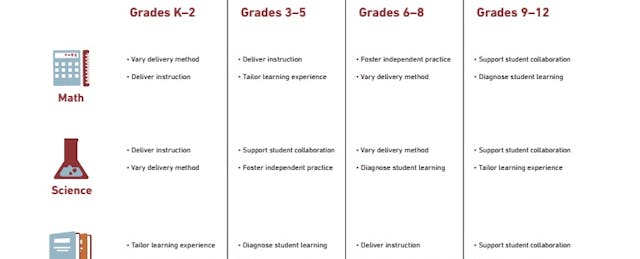What do teachers need and want?
Great content. And great content aligned to the standards.
At the ASU GSV conference today, the Gates Foundation released a report that summarizes survey results from 3100 teachers and 1,250 students about what they want and need from digital tools.
Questions were:
- What do teachers want and need from digital instructional tools?
- How can product developers use this information to more effectively serve students, teachers, and schools?
- What do we know about how teachers and districts select and purchase digital instructional tools?
- What do we know about the overall market for digital instructional tools?
The research captured 964 student-facing digital products—those used directly by students for learning. About 40% of currently available digital products focus on an individual academic subject, with most focused on either math or ELA.
When asked to list the top five products they direct their students to use frequently, teachers named only 53% of the 964 products captured in the survey. And only 54% of teachers perceive the digital products their students use frequently to be “effective.” (The survey let the teachers define what “effective” meant to them.)
Some results on the investment side were these:
- Investors are supporting “more and more” student-facing digital products used directly by students for learning.
- The average investment size has decreased from $11 million in 2010 to $2.3 million in 2013 as seed stage capital.
- Series A capital has remained “relatively flat” for companies that target K-12 schools in the US.
- District plans for expanding the use of digital tools suggest that the market “may grow” over the next three years.
A panel at GSV that followed the release of the report by Gates Foundation’s Stacey Childress included several teachers and BuzzFeed reporter Molly Hensley-Clancy, who talked about the results.
“I’ve found a lot of tools that help students do well on the NWA MAP assessments, but not for the Common Core,” observed Arelys Villeda, an elementary ELA teacher in the Chicago Public Schools district.
“It’s laughable to put a 'Common Core-aligned' sticker on products. It almost insults your intelligence,” added Tanesha Dixon, a middle school social studies teacher, in DC Public Schools.
Noted Chris Liang-Vergara, Chief of Learning Innovation at LEAP Innovations in Chicago: “Did you create your content for the Common Core? If teachers are disappointed they will shy away from edtech.”
When choosing technology, Dixon says:
“I look at effectiveness. Technology has the power to do things that are humanly impossible. It has the power to leverage and reach all your learners. But lot of social studies products are like 'Trivial Pursuit.' That’s not rigorous. It’s about making connections to their daily lives. I don’t see products doing that.”
“I realize that I haven’t found a single edtech tool that helps my students communicate with each other and develop communications skills,” added Villeda.
Villeda, Dixon and Liang-Vergara encouraged startups to reach out to educators for feedback. “We’re very thirsty” to hear about new developments, said Villeda.
“Just like developers like to smooze on the golf course, reach out to us. I’ll play 18 holes with you, too!” promised Dixon.
The full report is available here. Or, download the full data file (Teacher Survey Results) that represents all the findings of the research.


